The broadcast switchers market is projected to grow from USD 2.4 billion in 2025 to USD 4.2 billion by 2035, with a compound annual growth rate (CAGR) of 5.7%. A breakpoint analysis reveals key stages of growth over time. In 2024, the market value stands at USD 2.1 billion, marking the baseline. The market then progresses to USD 2.4 billion in 2025, driven by the growing demand for enhanced video production technologies across the broadcasting sector. From 2025 to 2027, the market shows steady growth, reaching USD 2.3 billion in 2026 and USD 2.4 billion in 2027. By 2028, the market climbs to USD 2.6 billion, reflecting increased adoption of advanced broadcast switchers, especially in live events and sports broadcasting. By 2029, the market reaches USD 2.7 billion as more industries adopt professional-grade video production equipment, expanding the market's reach.The growth accelerates after 2030, with the market reaching USD 2.9 billion in 2030 and USD 3.2 billion in 2032. By 2034, the market value increases to USD 3.8 billion, driven by technological advancements in broadcasting. By 2035, the market peaks at USD 4.2 billion, reflecting the increasing demand for high-quality content in an evolving media landscape. This long-term growth is propelled by innovations and expanding applications of broadcast switchers across industries.

| Metric | Value |
|---|---|
| Broadcast Switchers Market Estimated Value in (2025 E) | USD 2.4 billion |
| Broadcast Switchers Market Forecast Value in (2035 F) | USD 4.2 billion |
| Forecast CAGR (2025 to 2035) | 5.7% |
The broadcast switchers market is experiencing steady growth, driven by the expanding demand for high-quality live production and real-time content switching across various broadcasting platforms. The increasing transition from standard definition to high-definition and ultra-high-definition formats is significantly influencing demand for advanced switching systems. Technological advancements such as IP-based workflows, integration of software-defined functionality, and enhanced compatibility with virtual production environments are shaping the market’s direction.
The proliferation of over-the-top platforms and the rise in live streaming of sports, entertainment, and corporate events are further expanding the application scope for broadcast switchers. Growing investments by broadcasters in upgrading infrastructure to handle multi-format and multi-platform output are providing additional momentum.
The need for seamless switching, improved operational efficiency, and reduced latency in live production is encouraging adoption across both traditional and digital broadcasting environments As content consumption patterns evolve and competition among broadcasters intensifies, the market is expected to see sustained growth, supported by ongoing product innovations and the integration of intelligent automation in switching systems.
The broadcast switchers market is segmented by system, application, end use, and geographic regions. By system, market is divided into Hardware and Software. In terms of application, market is classified into Sports, News, and Live entertainment. Based on end use, broadcast switchers market is segmented into TV broadcasters, Cable & satellite providers, Production houses, Live event organizers, and Educational institutions. Regionally, the broadcast switchers industry is classified into North America, Latin America, Western Europe, Eastern Europe, Balkan & Baltic Countries, Russia & Belarus, Central Asia, East Asia, South Asia & Pacific, and the Middle East & Africa.
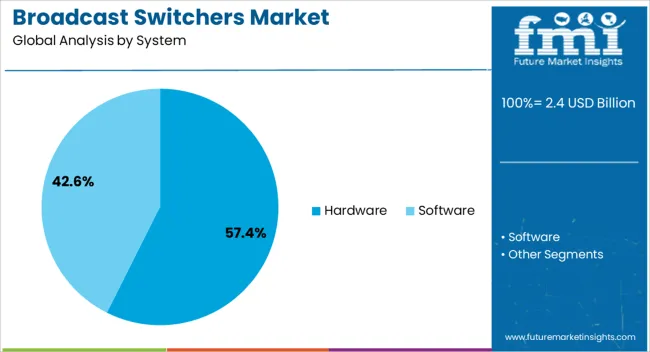
The hardware system segment is projected to hold 57.4% of the broadcast switchers market revenue share in 2025, making it the leading system type. This dominance is being driven by the continued reliance on dedicated, high-performance hardware solutions for mission-critical broadcast environments. Hardware switchers offer unmatched reliability, minimal latency, and consistent performance, which are essential in live production scenarios where errors can result in costly disruptions.
The segment benefits from robust construction, long operational lifespans, and the ability to handle multiple input formats simultaneously. Growing investments in ultra-high-definition and high frame rate broadcasting are further enhancing the demand for advanced hardware-based systems that can manage large-scale productions without compromising quality.
While software-based solutions are gaining traction, hardware remains preferred for high-end studio and outside broadcast operations due to its stability and proven track record The capacity to integrate with modern IP workflows while maintaining traditional SDI compatibility is also reinforcing the appeal of hardware switchers among broadcasters and production houses.
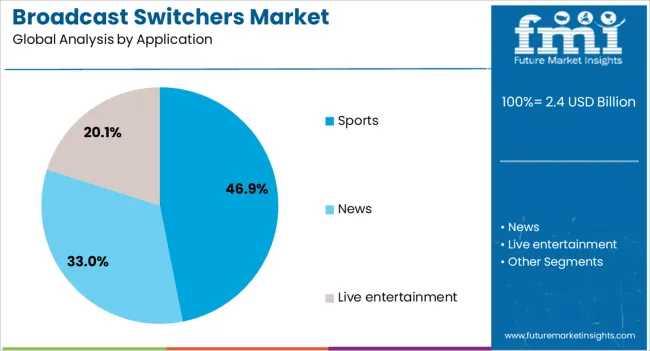
The sports application segment is anticipated to account for 46.9% of the broadcast switchers market revenue share in 2025, positioning it as the largest application category. Its leadership is supported by the high demand for real-time content switching, replay integration, and multi-camera management in live sports broadcasting. Sports coverage requires split-second decision-making and instant transitions between multiple video sources, making reliable and high-speed switchers essential.
The rise in global sports viewership, coupled with the increasing number of sporting events broadcast across television and streaming platforms, is driving significant investment in advanced switching systems. The ability to support high frame rate and ultra-high-definition formats ensures that viewers receive an enhanced visual experience.
Additionally, the growth of sports-related digital content, including highlights and interactive viewing options, is further contributing to the segment’s expansion The integration of IP-based workflows, slow-motion replay systems, and virtual graphics capabilities into sports broadcasting is expected to sustain demand for high-performance switchers in this segment.
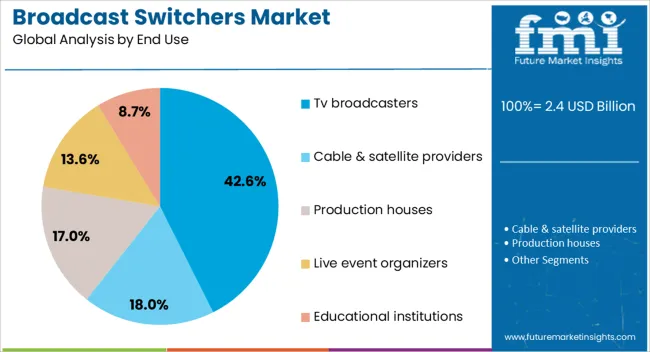
The TV broadcasters segment is expected to represent 42.6% of the broadcast switchers market revenue share in 2025, making it the leading end-use category. This dominance is attributed to the critical role broadcast switchers play in delivering seamless, high-quality programming to large audiences. Television broadcasters require equipment capable of handling complex live production workflows, integrating multiple video and audio sources, and delivering real-time output across various channels.
The ongoing upgrades to ultra-high-definition broadcasting, coupled with the need for flexible and scalable production setups, are fueling investments in advanced switcher systems. The segment benefits from the broadcasters’ focus on reducing latency, improving operational efficiency, and enhancing the viewer experience.
Growing competition among TV channels is also encouraging adoption of switchers with advanced automation, remote control, and integration capabilities As audience expectations for high production value content increase, the reliance on high-performance broadcast switchers by TV broadcasters is expected to remain strong, supporting the segment’s continued leadership in the market.
The global broadcast switchers market is experiencing significant growth, driven by the increasing demand for high-quality video content, advancements in broadcasting technology, and the rise of live streaming platforms. The transition from analog to digital broadcasting and the adoption of IP-based infrastructures are further propelling the market's expansion. The growing popularity of esports and live event broadcasting is contributing to the demand for advanced broadcast switchers capable of handling high-resolution video and multiple input sources. As the industry continues to evolve, broadcast switchers are becoming more critical to delivering seamless and high-quality live broadcasts.
The increasing demand for high-definition (HD) and ultra-high-definition (UHD) content is driving broadcasters to adopt advanced switchers that can handle higher resolutions and provide seamless switching between multiple video sources. The rise of live streaming platforms and over-the-top (OTT) services has created a need for efficient and reliable broadcast switchers to manage real-time video feeds and ensure high-quality streaming experiences for viewers. Advancements in broadcasting technology, such as the integration of artificial intelligence (AI) and machine learning (ML) for automated workflows, are enhancing the capabilities of broadcast switchers, making them more efficient and user-friendly. The adoption of IP-based infrastructures allows for more flexible and scalable broadcasting solutions, further fueling the demand for advanced broadcast switchers .
The increasing demand for high-definition (HD) and ultra-high-definition (UHD) content is driving broadcasters to adopt advanced switchers that can handle higher resolutions and provide seamless switching between multiple video sources. The rise of live streaming platforms and over-the-top (OTT) services has created a need for efficient and reliable broadcast switchers to manage real-time video feeds and ensure high-quality streaming experiences for viewers. Advancements in broadcasting technology, such as the integration of artificial intelligence (AI) and machine learning (ML) for automated workflows, are enhancing the capabilities of broadcast switchers, making them more efficient and user-friendly. The adoption of IP-based infrastructures allows for more flexible and scalable broadcasting solutions, further fueling the demand for advanced broadcast switchers .
The broadcast switchers market presents numerous opportunities for innovation and expansion. The integration of AI and ML into broadcast switchers offers the potential for automated workflows, enhancing efficiency and reducing the need for manual intervention. The adoption of cloud-based broadcasting solutions enables remote production capabilities, reducing infrastructure costs and increasing flexibility. The demand for compact and portable broadcast switchers is rising, driven by the need for on-the-go production solutions. Furthermore, the expansion of esports and live event broadcasting presents new avenues for the deployment of advanced broadcast switchers to meet the unique demands of these sectors .
The transition to IP-based broadcasting is enabling more flexible and scalable production workflows, allowing for easier integration of various equipment and platforms. The increasing use of cloud-based broadcasting solutions is facilitating remote production capabilities, reducing the need for on-site infrastructure. The adoption of virtual and augmented reality technologies is enhancing the immersive experience of live broadcasts, driving the demand for advanced broadcast switchers capable of handling complex video feeds. Additionally, the demand for compact and portable broadcast switchers is growing, as broadcasters seek solutions that offer mobility without compromising on performance .
| Country | CAGR |
|---|---|
| China | 7.7% |
| India | 7.1% |
| Germany | 6.6% |
| France | 6.0% |
| UK | 5.4% |
| USA | 4.8% |
| Brazil | 4.3% |
The global broadcast switchers market is projected to grow at a CAGR of 5.7% from 2025 to 2035. China leads with a growth rate of 7.7%, followed by India at 7.1%, and France at 6.0%. The United Kingdom and the United States show more moderate growth rates of 5.4% and 4.8%, respectively. This growth is driven by increasing demand for high-definition and 4K broadcasting solutions, as well as investments in live sports, media, and entertainment events. Emerging markets like China and India are expanding rapidly, while developed markets focus on advanced broadcasting technologies. The analysis spans over 40+ countries, with the leading markets shown below.
China is expected to lead the global broadcast switchers market, growing at a projected CAGR of 7.7% from 2025 to 2035. The country’s rapidly expanding media and entertainment industry, coupled with increasing investments in sports broadcasting, is driving demand for broadcast switchers. The growing adoption of high-definition (HD) and 4K technologies in broadcasting is further fueling market growth. The shift towards digital and smart broadcasting solutions, including IP-based infrastructure, is creating significant demand for advanced broadcast switchers. The government’s initiatives to support media industry development and the rise of online streaming platforms are also expected to contribute to the market’s expansion.
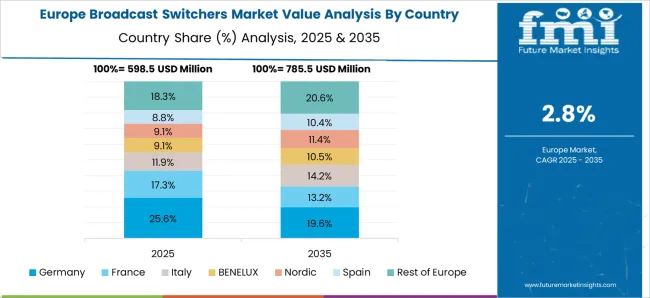
The broadcast switchers market in France is expected to grow at a steady pace, with a projected CAGR of 6.0% from 2025 to 2035. The country’s strong presence in television and film production, coupled with its increasing demand for high-definition and 4K broadcast solutions, is driving the market for broadcast switchers. France’s investments in sports broadcasting and live event production are also contributing to market growth. As the country continues to upgrade its broadcast infrastructure and adopt IP-based solutions for broadcasting, there will be growing demand for advanced switchers. France’s focus on innovation in broadcasting technologies is expected to further boost market expansion.
The broadcast switchers market in the United Kingdom is projected to grow at a CAGR of 5.4% from 2025 to 2035. The UK’s established media and entertainment industry, coupled with its increasing demand for high-definition and 4K broadcast solutions, is driving the market. The country’s growing investments in live broadcasting for events like sports, music, and news are further contributing to market expansion. The rise of streaming platforms and the shift towards IP-based broadcast solutions are expected to continue influencing demand for advanced broadcast switchers. As the UK continues to innovate in broadcasting technology, the market is set for steady growth.
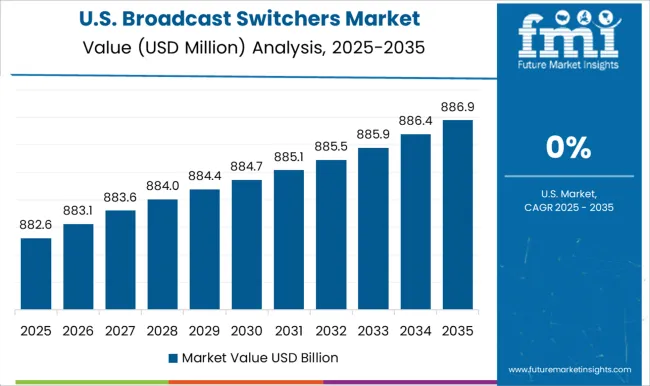
The USA broadcast switchers market is projected to grow at a CAGR of 4.8% from 2025 to 2035. The USA media industry’s shift towards digital broadcasting and the increasing adoption of HD and 4K technologies in television and film production are driving the demand for advanced broadcast switchers. The rise of live sports and entertainment broadcasting, coupled with the increasing number of streaming platforms, is also fueling market growth. As the USA continues to invest in modernizing its broadcast infrastructure and adopting new broadcast technologies, the demand for broadcast switchers is expected to grow steadily.
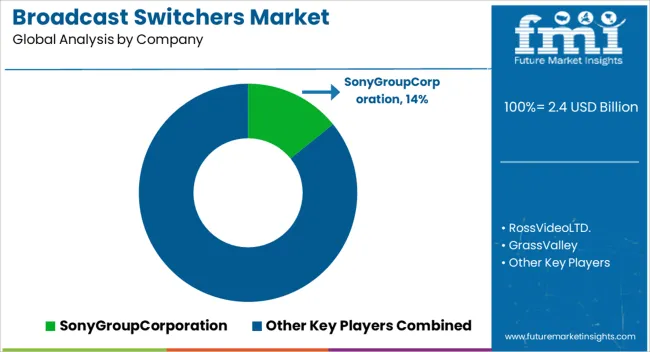
The broadcast switchers market is comprised of numerous companies that provide cutting-edge solutions for live video production, broadcasting, and streaming. Key players in this market include Sony Group Corporation, known for its high-quality video equipment; Ross Video Ltd., recognized for its innovative switchers such as the Ultrix and Carbonite series; Grass Valley, which offers a variety of switchers for different production needs; Panasonic Holdings Corporation, which is renowned for its reliable broadcasting technology; and Blackmagic Design Pty. Ltd., which is known for its cost-effective, feature-rich products. Other notable players include Crestron Electronics, Inc., specializing in control systems and integrated solutions; Roland Corporation, which provides compact and portable switchers; FOR-A Company Limited, known for its versatile broadcast equipment; Datavideo, offering budget-friendly solutions for smaller-scale productions; Broadcast Pix Inc., specializing in integrated production switchers; Pure Link, focusing on AV signal distribution and switching; and tv ONE, which offers video and audio processing equipment.
These companies stand out through innovation, product quality, and exceptional customer service. Ross Video’s Ultrix Acuity and Carbonite series are celebrated for their scalability and IP-native capabilities, which address the evolving demands of modern broadcast environments. Similarly, Blackmagic Design’s ATEM switchers are highly regarded for their affordability and comprehensive feature set, making them ideal for both professionals and hobbyists. Additionally, companies like Crestron Electronics and tv ONE provide seamless integration of broadcast switchers with other AV systems, ensuring flexibility and ease of use for complex live production setups.
Sony Group Corporation
Ross Video Ltd.
Grass Valley
Panasonic Holdings Corporation
Blackmagic Design Pty. Ltd.
FOR-A Company Limited
Broadcast Pix, Inc.
tvONE
| Item | Value |
|---|---|
| Quantitative Units | USD Billion |
| System | Hardware and Software |
| Application | Sports, News, and Live entertainment |
| End Use | TV broadcasters, Cable & satellite providers, Production houses, Live event organizers, and Educational institutions |
| Regions Covered | North America, Europe, Asia-Pacific, Latin America, Middle East & Africa |
| Country Covered | United States, Canada, Germany, France, United Kingdom, China, Japan, India, Brazil, South Africa |
| Key Companies Profiled | Sony Group Corporation; Ross Video Ltd.; Grass Valley; Panasonic Holdings Corporation; Blackmagic Design Pty. Ltd.; FOR-A Company Limited; Broadcast Pix, Inc.; tvONE. |
| Additional Attributes | Dollar sales by product type (SDI switchers, HDMI switchers, IP-based switchers) and end-use segments (television broadcasters, live event producers, corporate AV, educational institutions, OTT platforms). Demand dynamics are driven by the increasing consumption of live streaming content, the shift towards 4K and 8K broadcasting, and the adoption of IP-based workflows. Regional trends show strong growth in North America, Asia-Pacific, and Europe, fueled by investments in broadcast infrastructure, the rise of esports and gaming broadcasts, and the expansion of OTT platforms. |
The global broadcast switchers market is estimated to be valued at USD 2.4 billion in 2025.
The market size for the broadcast switchers market is projected to reach USD 4.2 billion by 2035.
The broadcast switchers market is expected to grow at a 5.7% CAGR between 2025 and 2035.
The key product types in broadcast switchers market are hardware and software.
In terms of application, sports segment to command 46.9% share in the broadcast switchers market in 2025.






Full Research Suite comprises of:
Market outlook & trends analysis
Interviews & case studies
Strategic recommendations
Vendor profiles & capabilities analysis
5-year forecasts
8 regions and 60+ country-level data splits
Market segment data splits
12 months of continuous data updates
DELIVERED AS:
PDF EXCEL ONLINE
Broadcast Equipment Market Growth - Trends & Forecast 2025 to 2035
LTE and 5G Broadcast Market – Future of Video Streaming
Television Broadcasting Services Market Insights – Growth & Forecast 2023-2033
4K Satellite Broadcasting Market Size and Share Forecast Outlook 2025 to 2035
Automatic Dependent Surveillance-Broadcast (ADS-B) System Market Size and Share Forecast Outlook 2025 to 2035

Thank you!
You will receive an email from our Business Development Manager. Please be sure to check your SPAM/JUNK folder too.
Chat With
MaRIA